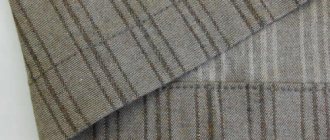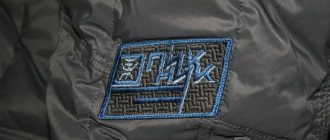How to cut the hem of a dress
Not every new thing is the right length; sometimes you have to shorten it. And if you sew at home, you often have to bend a new product.
It is important to learn the invisible hem. And the overall impression of the girl’s appearance depends on how the bottom of the outfit looks.
To perform this operation at home, you will need patience and knowledge of the techniques that experienced seamstresses share with us.
Hemming the bottom of a circle skirt
Aligning and processing the lower edge of the skirt is one of the important stages of tailoring, which does not forgive mistakes - an uneven edge will not add beauty to the product.
There are several ways to finish the edge of a skirt. The simplest of them is processing with an overlock and stitching the bottom to the width of the stitch made. The method is more complicated - the overlocked edge is secured using blind stitches, which are done manually. Aerobatics is the use of the Moscow seam, for which you cannot do without experience in sewing.
Alignment according to the rules is done like this - the skirt is left to “hang” at least overnight, so that the product can take the desired shape under the influence of its own weight. After this, you can begin leveling using a straight edge.
Skater skirt with yoke: HOW TO FOLD THE BOTTOM OF THE SUN
The necessary tools are a table, a meter ruler, chalk and someone to help.
First you need to determine the highest point of the skirt. What does this mean - we find a place on the skirt with the shortest length, measure it and adjust all other lengths to this value, placing marks with the measured value along the entire length of the product.
We lay out the skirt on the table and begin to connect the marks made manually or using a measuring ruler. If the difference in length is too large in some places, cut off the excess. Following the arc drawn in chalk, you can use an overlock to finish the edge. Blind stitches are carefully done by hand.
How to fold a dress made of thick fabrics
A dress made of thick fabric most often has a straight cut. The hem should be 3-4 cm.
- Take a piece of paper.
- Draw the width of the hem on it.
- Bend the edge of the hem this distance and iron it.
- Then sew a blind seam or a “goat” seam.
In the flared lines along the bottom of the product, lay two parallel lines (Fig. 7). The bottom line needs to be slightly gathered. Along the line of the top stitch, fold the fabric inside out, pin it with pins and press it.
How to hem tulle with your own hands using bias tape
This processing method is usually used for mesh or embroidered tulle. Bias tape is sold at any sewing supply store.
To perform the operation, a special foot or snail foot is used.
During the step-by-step master class, thick dyed fabric and contrasting trim were chosen for clarity.
We pre-iron the fabric and trim the straight edge. Insert the cut into the binding. If you are confident in your skill, you can do without basting. But, for reliability, we still advise you, if not basting, then at least secure the tape with pins at intervals of 4-5 cm.
The binding should be sewn on with a straight stitch in increments of 3-4 mm. While sewing, we periodically stop and check the quality of the joints on both sides.
When performing the operation, it is advisable to support the product with your hands, controlling the direction of the seam and the amount of entry.
When the stitching is done carefully, we get a beautifully designed edge.
Blind seam. How to do
I urgently need to bend the hem, but I don’t have a machine. We'll do without a machine. Many dressmakers always use a hidden seam.
Hand hemming can be done on dresses made from wool or suit fabrics. Needle punctures on such materials will not be visible on the front side.
To hem a dress by hand, you need to take the right thread. First of all, it must match the color of the product. It is better to choose a thin, non-twisted thread so that it does not twist during the process.
It is necessary to hem with a thread not in two layers, but in one, otherwise a rough puncture will be visible on the front side
. How to sew with a blind seam? Use the needle to grab only one thread at a time, then there will be no marks left on the front side. The photo shows how a hidden stitch is sewn.
A knitted dress can be hemmed by using a double stitch on a machine. First, the edge is processed using an overlocker, the excess is cut off, and a double seam is sewn from the face. There is a special needle that can make such a stitch. Or you can first lay one line, then, retreating 0.7-0.8 cm, lay another one. Before performing this operation on a dress, practice on a different material.
The hidden seam can be like in the photo. It is very convenient to hem the hem of a product made of dense material.
How to hem curtains from the bottom at home: step-by-step instructions describing the process
There are two ways to shorten curtains - trimming and folding. In the first case, you should measure the fabric correctly and cut the fabric to the required length. Before starting work you must:
- Wet the curtains and hang them on the curtain rod without squeezing them. Leave the textiles for 3 days. This will allow the fabric to sag and allow more accurate measurements to be taken.
- Select threads for curtains. They must match the shade of the material.
- Prepare suitable pins. Do not use thick tools as they leave holes in the fabric.
The shortening method and type of seam are chosen depending on the type of material:
- Tulle, organza, and other thin fabric can be set on fire. This will seal the threads and prevent them from unraveling. The main thing is to perform the procedure carefully so as not to set fire to the canvas.
- Dense material may bend after hemming. This problem often occurs with blackout fabric. To prevent the night curtain from losing its shape, a weighting agent is inserted into the bend. Usually a wooden plank is used. If the products were originally sold with a load, the length should be cut not from the bottom, but from the top. To prevent the curtain from losing its shape, curtain tape is sewn on.
- If the material crumbles, the edge is additionally treated with a zigzag seam. This will fix the threads and increase the service life of the fabric.
- Double-sided curtains cannot be hemmed in the usual way, as this disrupts the design of the canvas. Such curtains do not have a front or back side. In this situation, the textiles are cut, the edges are folded inward, and sewn with a hidden seam.
To shorten curtains, the following types of processing are distinguished:
- Classic seam. This is a straight stitch that is suitable for both light curtains and heavy curtains. The fabric is simply folded and stitched. If the material crumbles, make 2-5 bends.
- Blind seam. These are hidden stitches that are used to seamlessly join two warps together. They do not pierce the fabric with a needle, but make a small grab of the thread. This results in a neat hem.
- Using edging. When the curtain fabric is thick, it is not folded. If you fold the material and sew a seam, the edge will be too thick. He looks unattractive. In such a situation, excess fabric is removed, that is, the bottom is cut to the desired length. No allowance is left. The braid is sewn on with a hidden seam.
- Gusset. This is the most difficult way to shorten curtains, but after the procedure the products look aesthetically pleasing. The angle turns out to be neat, not too tight, and not puffy. This method can only be used by experienced dressmakers.
Processing the bottom of the curtain with a corner
Before starting the hemming process, you need to take measurements of the fabric. To carry out the procedure correctly, adhere to the following algorithm:
- Textiles are laid out on a flat surface. It's better to work on the floor.
- If the material is very wrinkled, it will be ironed.
- Use a centimeter or tape measure to measure the desired size.
Fabric trimming is performed only if the fabric is too long. If the size of the canvas is 10 cm larger than the required value, the textiles are simply folded and hemmed. This will allow the curtains to be returned to their original dimensions if necessary.
When the measurement has been made and the modeling method has been selected, they proceed directly to the procedure. This can be done in several ways.
Manually
This is the longest method of hemming curtains. It is usually used if you need to reduce the length of the curtains without removing them from the curtain rod.
Procedure:
- The curtains are measured. On the wrong side, use chalk to mark to what length the curtains need to be folded. If necessary, trim off the excess.
- They make a bend. The fabric is folded flat and ironed. Fasten with pins. For thick curtains, the material is folded only once. Tulle can be folded in 2-3 layers.
- Perform hemming. The main condition of this method is to leave a thread 2 cm long at the ends, and not thread it to the end, so as not to form a crease.
On a sewing machine
This is the fastest way to hem curtains. Algorithm:
- The fabric is folded and trimmed. Fasten with pins.
- Perform estimates.
- Textiles are sewn on a sewing machine.
- Remove the mark.
- The threads are tied into a knot at the ends.
Using adhesive tape
To bend curtains using this strip, proceed as follows:
- Measure the width of the canvas. This value must correspond to the length of the adhesive strip. If the indicators do not match, the procedure will not work.
- The curtain is folded. To fix the material, heat treatment of the canvas is performed.
- Adhesive tape is inserted into the crack. The top of the fabric is treated with a hot iron.
This method of shortening the length of curtains can only be used for light fabrics. The sticky strip will not support the weight of the dense material.
"Goat" for knitwear
For dresses made of knitwear, the goat stitch is the most comfortable seam.
How to make a hem step by step:
- Fold the hem and iron.
- Insert the needle into the fabric from the wrong side and secure the thread.
- Then hook one thread of the fabric on the right side.
- Above the seam allowance, make a small stitch from right to left. It is advisable to capture as little tissue as possible.
- Next, at the seam allowance itself, make a stitch from left to right, grabbing the fabric.
- You should get a seam that looks like the letter “X”.
In this way, go over the entire hem of the bottom. Make sure that the threads are not visible on the front side of the product. Try to grab only one or two threads of material. The goat is a reliable seam; the bottom of the product will never unravel, even after numerous washes.
Little tricks for hemming knitted items
A knitted dress can stretch so that the hem becomes uneven, spoiling the entire appearance. You can fold it with a goat, but there is one surefire trick that will help you update your favorite dress.
- Take a needle thinner than the one on which the outfit was knitted. Pass through the loops of one row. It is very important.
View from the inside.
- Undo those rows that are above the knitting needle.
Wind the threads into a ball, hold them over the steam, and rewind them into a ball again. They will become even again. From these you can tie the bottom with any pattern or close the loops.











